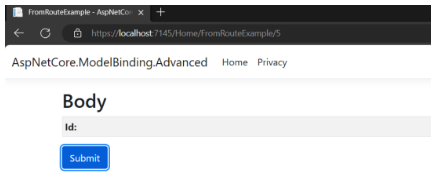- 联系我们
- duidaima.com 版权声明
- 闽ICP备2020021581号
-
 闽公网安备 35020302035485号
闽公网安备 35020302035485号
 闽公网安备 35020302035485号
闽公网安备 35020302035485号
4 模型绑定源
using AspNetCore.ModelBinding.Advanced.Models;
using Microsoft.AspNetCore.Mvc;
using System.Diagnostics;
namespace AspNetCore.ModelBinding.Advanced.Controllers
{
public class HomeController : Controller
{
private readonly ILogger<HomeController> _logger;
public HomeController(ILogger<HomeController> logger)
{
_logger = logger;
}
public IActionResult Palces(string[] places) => View(places);
}
}
注意这个Action方法有个string类型的参数并且被命名为places,模型绑定机制会搜索form表单数据中名字为places的项, 路由变量和查询字符串,如果发现将会绑定到方法的参数@model string []
@{
ViewData["Title"] = "Places";
}
<h2></h2>
@if (@Model.Length == 0)
{
<form asp-action="Places" method="post">
@for (int i = 1; i <= 3; i++)
{
<div class="form-group">
<label>Place @i</label>
<input name="places" class="form-controller" />
</div>
}
<button type="submit" class="btn btn-primary">提交</button>
</form>
}
else
{
<table class="table table-sm table-bordered table-striped">
@foreach (var place in Model)
{
<tr>
<td>Place</td>
<td>@place</td>
</tr>
}
</table>
<a asp-action="Places" class="btn btn-primary">返回</a>
}
视图中包含一个数组类型的模型,if-else块语句检查是否为空,它使用了代码– @Model.Length == 0判断,如果不为空使用循环遍历模型并显示,否则,在这种情况下,如果模型为空,表单会添加3个places并显示3个相同的输入框。 <div class="form-group">
<label>Place 1</label>
<input name="places" class="form-controller" />
</div>
<div class="form-group">
<label>Place 2</label>
<input name="places" class="form-controller" />
</div>
<div class="form-group">
<label>Place 3</label>
<input name="places" class="form-controller" />
</div>
你能看到所有的这3个输入元素有相同的名字places,并且这个名字action方法的参数名称是相同的,因此模型绑定将会应用一个数组的绑定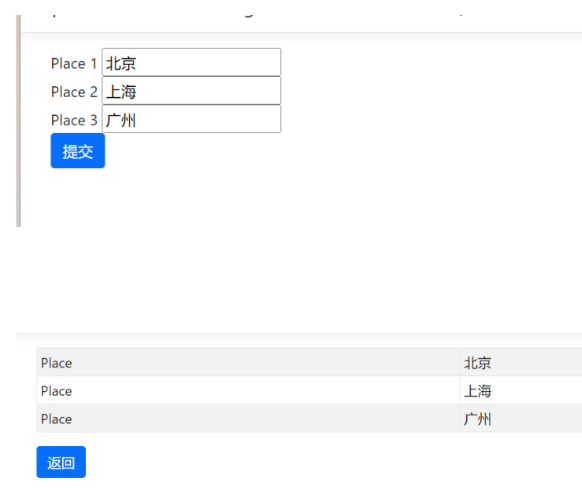
public IActionResult Places(List<string> places) => View(places);我们稍微修改一下Places.cshtml视图文件:
@model List<string>
@{
ViewData["Title"] = "Places";
}
<h2></h2>
@if (@Model.Count == 0)
{
<form asp-action="Places" method="post">
@for (int i = 1; i <= 3; i++)
{
<div class="form-group">
<label>Place @i</label>
<input name="places" class="form-controller" />
</div>
}
<button type="submit" class="btn btn-primary">提交</button>
</form>
}
else
{
<table class="table table-sm table-bordered table-striped">
@foreach (var place in Model)
{
<tr>
<td>Place</td>
<td>@place</td>
</tr>
}
</table>
<a asp-action="Places" class="btn btn-primary">返回</a>
}
你可以像之前一样运行和提交表单,提交时,你添加的3个places文本会显示在浏览器中public class PersonAddress
{
public string City { get; set; }
public string Country { get; set; }
}
接下来,进入Home控制器并添加一个新的名字为Address的方法, 具体方法的代码如下:public IActionResult Address() => View(); [HttpPost] public IActionResult Address(List<PersonAddress> address) => View(address);接下来,在Views->Home文件夹内创建一个名字为Address视图,代码如下:
@model List<PersonAddress>
@{
ViewData["Title"] = "Address";
}
<h2>Address</h2>
@if (Model.Count == null)
{
<form asp-action="Address" method="post">
@for (int i = 0; i < 3; i++)
{
<fieldset class="form-group">
<legend>Address @(i + 1)</legend>
<div class="form-group">
<label>City:</label>
<input name="[@i].City" class="form-control" />
</div>
<div class="form-group">
<label>Country:</label>
<input name="[@i].Country" class="form-control" />
</div>
</fieldset>
}
<button type="submit" class="btn btn-primary">Submit</button>
</form>
}
else
{
<table class="table table-sm table-bordered table-striped">
<tr><th>City</th><th>Country</th></tr>
@foreach (var address in Model)
{
<tr><td>@address.City</td><td>@address.Country</td></tr>
}
</table>
<a asp-action="Address" class="btn btn-primary">Back</a>
}
视图中包含一个PersonAddress集合的Model,是一个复杂类型的集合,当在模型中没有数据显示时它呈现一个表单,表单包含了3对City和Country输入框前缀使用了数组索引具体代码如下:<fieldset class="form-group">
<legend>Address 1</legend>
<div class="form-group">
<label>City:</label>
<input name="[0].City" class="form-control" />
</div>
<div class="form-group">
<label>Country:</label>
<input name="[0].Country" class="form-control" />
</div>
</fieldset>
<fieldset class="form-group">
<legend>Address 2</legend>
<div class="form-group">
<label>City:</label>
<input name="[1].City" class="form-control" />
</div>
<div class="form-group">
<label>Country:</label>
<input name="[1].Country" class="form-control" />
</div>
</fieldset>
<fieldset class="form-group">
<legend>Address 3</legend>
<div class="form-group">
<label>City:</label>
<input name="[2].City" class="form-control" />
</div>
<div class="form-group">
<label>Country:</label>
<input name="[2].Country" class="form-control" />
</div>
</fieldset>
这些输入框被创建通过循环从i->0到i->2,当提交表单时,模型绑定使用name属性的int索引值创建List<PersonAddress>集合的元素,前缀为[0]的name属性的值对应第一个PersonAddress对象,前缀为[1]的name属性的值对应第二个PersonAddress对象, 最后 前缀为[2]的name属性的值对应第三个对象,如果你有更多的对象,可以使用这种模式, 这是一个经典的例子针对模型绑定复杂类型的集合。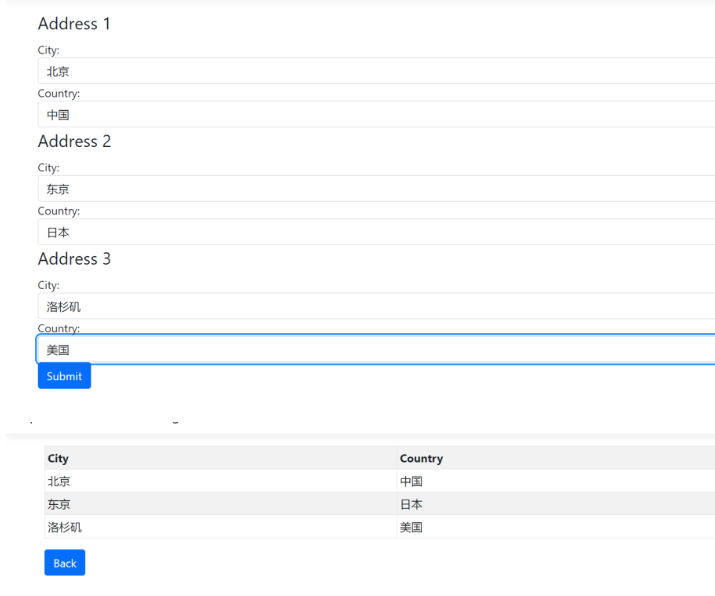
|
名称 |
描述 |
|
FromQuery |
使用这个特性指定查询字符串作为模型绑定的数据源 |
|
FromHeader |
使用这个特性指定请求的header作为模型绑定的数据源 |
|
FromBody |
使用这个特性指定请求body作为模型绑定的数据源 |
|
FromForm |
使用这个特性指定表单数据作为模型绑定的数据源 |
|
FromRoute |
使用这个特性指定路由数据作为模型绑定的数据源 |
为什么使用模型绑定?模型绑定技术是可以将HTTP请求中的数据转换到控制器的方法的一种最简单的方式,数据转换以不同的方式完成像form、body、headers、routes & query strings,模型绑定使得所有的这些工作很平滑,项目也减少了大量开发时间
。
FromForm特性public class Employee
{
public int Id { get; set; }
public string Name { get; set; }
}
在Home控制器中创建一个名字为FromFormExample的方法,在Post版本方法的参数中添加一个FromForm特性– [FromForm] Employee model, 这告诉模型从表单域中绑定获取参数的值。public IActionResult FromFormExample() => View();
[HttpPost]
public IActionResult FromFormExample([FromForm] Employee model)
{
ViewBag.Message = "Employee data received";
return View();
}
现在在Views->Home文件内创建FromFormExample视图,在这个视图中我们创建一个html表单接受employee id和name@{
ViewData["Title"] = "FromFormExample";
}
<h2>From Form</h2>
<h3>@ViewBag.Message</h3>
<form method="post">
<div class="form-group">
<label>Id:</label>
<input name="Id" class="form-control" />
</div>
<div class="form-group">
<label>Name:</label>
<input name="Name" class="form-control" />
</div>
<button class="btn btn-primary">Submit</button>
</form>
访问https://localhost:7145/Home/FromFormExample[HttpPost] public Employee FromFormExample([FromForm]Employee model) => model;现在修改 FromFormExample 视图如下:
@{
ViewData["Title"] = "FromFormExample";
}
<h2>From Form</h2>
@section scripts {
<script src="https://ajax.aspnetcdn.com/ajax/jQuery/jquery-3.2.1.min.js"></script>
<script>
$(document).ready(function () {
$("button").click(function (e) {
data = new FormData();
data.append("id", 5);
data.append("name", "Donald Trump");
$.ajax("/Home/FromFormExample", {
method: "post",
processData: false,
contentType: false,
data: data,
success: function (data) {
$("#empId").text(data.id);
$("#empName").text(data.name);
}
});
});
});
</script>
}
<table class="table table-sm table-bordered table-striped">
<tr><th>Id:</th><td id="empId"></td></tr>
<tr><th>Name:</th><td id="empName"></td></tr>
</table>
<button class="btn btn-primary">Submit</button>
视图代码有一个ajax()方法调用FromFormExample方法,这个方法要求的数据来自于表单域 (因此它使用了[FromForm] 特性),因此我们添加值(employee id=5 和 name=Donald Trump) 在FormData, 看下面代码是如何工作:data = new FormData();
data.append("Id", 5);
data.append("Name", "Donald Trump");
表单数据的值被添加到ajax方法的data参数,访问 /Home/FromFormExample,并点击按钮,值像显示在HTML表格,图片显示如下: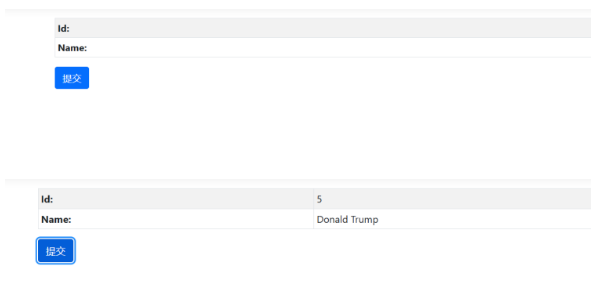
public IActionResult Body() => View(); [HttpPost] public Employee Body([FromBody]Employee model) => model;我们使用[FromBody]特性修饰Post版本的Body方法的参数,那意味着模型绑定从请求体中搜索Employee模型的值,注意方法返回的类型是Employee类型。
@{
ViewData["Title"] = "Body";
}
<h2>Body</h2>
@section scripts {
<script src="https://ajax.duidaima.com/ajax/jQuery/jquery-3.2.1.min.js"></script>
<script>
$(document).ready(function () {
$("button").click(function (e) {
$.ajax("/Home/Body", {
method: "post",
contentType: "application/json",
data: JSON.stringify({
id: 5,
name: "Donald Trump"
}),
success: function (data) {
$("#empId").text(data.id);
$("#empName").text(data.name);
}
});
});
});
</script>
}
<table class="table table-sm table-bordered table-striped">
<tr><th>Id:</th><td id="empId"></td></tr>
<tr><th>Name:</th><td id="empName"></td></tr>
</table>
<button class="btn btn-primary">Submit</button>
在这个视图中,当点击按钮时,像URL– /Home/Body 发送包含了JSON data的HTTP POST请求。data: JSON.stringify({
id: 5,
name: "Donald Trump"
})
Body方法Employee类型的参数接受到这个数据,并且以JSON格式返回给视图。最后,$.ajax()方法在Success调用回调方法,我们将接收到这个数据并将其显示在Table内。
public IActionResult Index(int id = 1)
{
return View(repository[id]);
}
现在我们进入– /Home/Index/1?id=2, id参数将获取值为1而不是2,因为查询顺序路由值,接下来是查询字符创,模型绑定在搜索查询字符创之前搜索路由的值。在URL数据中有3段 – /Home(1st segment)/Index(2nd segment)/1(3rd segment)包含的id值是1,因此你将看到Employee Id为1的数据。现在,我们能通过使用[FromQuery]特性非常容易的重写搜索行为,它将强迫模型绑定查找查询字符串针对Id参数。public IActionResult Index([FromQuery] int id = 1)
{
return View(repository[id]);
}
使用相同的URL– /Home/Index/1?id=2,这次你将看到第二个员工显示在浏览器,这意味着模型绑定在查询字符串中搜索值,代码如下:
public string Header([FromHeader]string accept) => $"Header: {accept}";
这个方法有一个名字为accept的参数,从http请求的header中绑定这个参数。运行你的应用程序,进入– /Home/Header,你将在浏览器中看到accept的值:Header: text/html,application/xhtml+xml,application/xml;q=0.9,image/webp,image/apng,*/*;q=0.8,application/signed-exchange;v=b3;q=0.9现在,我们在浏览器开发工具中检查Request Header的值,请检查下面步骤:

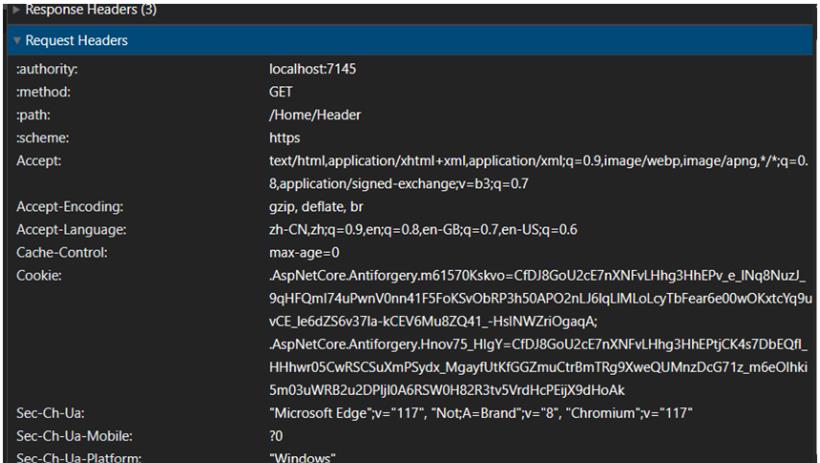
Accept Accept-Encoding Accept-Language Cache-Control Connection Host Upgrade-Insecure-Requests User-Agent现在,让我们绑定 User-Agent 值,因此使用Name属性配置FromHeader特性并且指定Header中的名称,在我们这种情况下,我们获取User-Agent
public string Header([FromHeader(Name = "User-Agent")]string accept) => $"Header: {accept}";
现在重新加载应用程序,查看URL–/Home/Header, 这次你将看到User-Agent的值被显示在浏览器上:
using Microsoft.AspNetCore.Mvc;
namespace AspNetCore.ModelBinding.Advanced.Models
{
public class FullHeader
{
[FromHeader]
public string Accept { get; set; }
[FromHeader(Name = "Accept-Encoding"))]
public string AcceptEncoding { get; set; }
[FromHeader(Name = "Accept-Language")]
public string AcceptLanguage { get; set; }
[FromHeader(Name = "Cache-Control")]
public string CacheControl { get; set; }
[FromHeader(Name = "Connection")]
public string Connection { get; set; }
[FromHeader(Name = "Host")]
public string Host { get; set; }
[FromHeader(Name = "Upgrade-Insecure-Requests")]
public string UpgradeInsecureRequests { get; set; }
[FromHeader(Name = "User-Agent")]
public string UserAgent { get; set; }
}
}
接下来,在Home控制器中创建一个FullHeader 方法:public IActionResult FullHeader(FullHeader model) => View(model);最后在Views->Home 文件夹下 创建一个 FullHeader 视图:
@model FullHeader
@{
ViewData["Title"] = "Full Header";
}
<h2>Header</h2>
<table class="table table-sm table-bordered table-striped">
<tr><th>Accept:</th><td>@Model.Accept</td></tr>
<tr><th>Accept-Encoding:</th><td>@Model.AcceptEncoding</td></tr>
<tr><th>Accept-Language:</th><td>@Model.AcceptLanguage</td></tr>
<tr><th>Cache-Control:</th><td>@Model.CacheControl</td></tr>
<tr><th>Connection:</th><td>@Model.Connection</td></tr>
<tr><th>Host:</th><td>@Model.Host</td></tr>
<tr><th>Upgrade-Insecure-Requests:</th><td>@Model.UpgradeInsecureRequests</td></tr>
<tr><th>UserAgent:</th><td>@Model.UserAgent</td></tr>
</table>
运行应用程序,进入URL– /Home/FullHeader 你会看到所有请求的Header:
这是一个典型的例子通过模型绑定捕获所有的HTTP Headers的值,将他们展示到表格中,在你的项目中使用这个代码。
public IActionResult FromRouteExample() => View(); [HttpPost] public string FromRouteExample([FromRoute] string id) => id;创建一个FromRouteExample在Views->Home 文件夹内
@{
ViewData["Title"] = "FromRouteExample";
}
<h2>Body</h2>
@section scripts {
<script src="https://ajax.aspnetcdn.com/ajax/jQuery/jquery-3.2.1.min.js"></script>
<script>
$(document).ready(function () {
$("button").click(function (e) {
$.ajax("/Home/FromRouteExample/5",
{
method: "post",
success: function (data) {
$("#id").text(data);
}
});
});
});
</script>
}
<table class="table table-sm table-bordered table-striped">
<tr><th>Id:</th><td id="id"></td></tr>
</table>
<button class="btn btn-primary">Submit</button>
当ajax方法调用这个action时,第三段url 发送的值为5(ajax方法调用/Home/FromRouteExample/5),因为使用了[FromRoute]特性,这个值将绑定到方法的参数,运行项目并且进入–/Home/FromRouteExample,点击提交按钮,你将看到html表格中显示的值为5